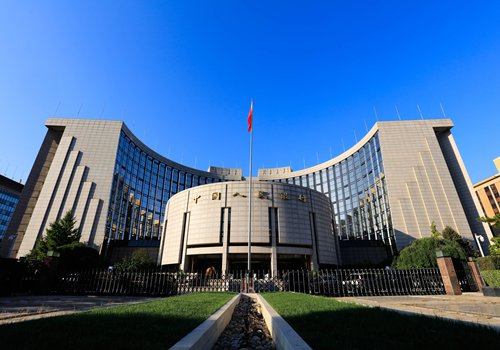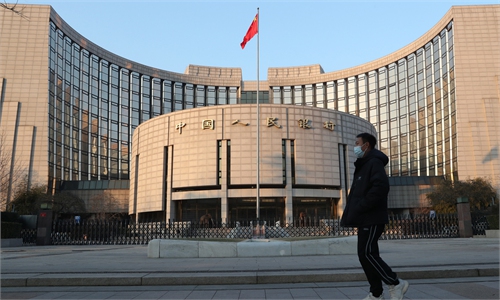
The headquarters of the People's Bank of China in Beijing Photo: CFP
New yuan loans in China slowed markedly in April, affected by the domestic Omicron epidemic flare-ups. The loans reached 645.4 billion yuan ($95.12 billion), down sharply from March's 3.13 trillion yuan, central bank data showed on Friday. The drop prompted expectations of a cut in the loan prime rate (LPR) in May.
The People's Bank of China (PBC), the central bank, said in the next step, it will stabilize credit, use multiple monetary policy tools to maintain abundant and reasonable liquidity, and ensure the growth of M2 and social financing is in line with nominal GDP growth. There will be an increase in the macro leverage ratio, but it will be maintained in a reasonable range.
Also, the central bank will conduct LPR reform and promote a reduction of credit cost for banks to lower China's financing cost. It will also guide financial institutions to lower charges and reasonably surrender part of their profits to the real economy.
The PBC said the slowdown in lending reflected the impact of the epidemic on the real economy. Coupled with supply chain disruptions and raw material price hikes, enterprises, especially small and medium-sized ones, face more operational difficulties, leading to a fall in demand for financing.
Broad M2 money supply grew 10.5 percent year-on-year as of the end of April, while the growth of outstanding total social financing slowed to 10.2 percent in April from 10.6 percent in March.
The Chinese economy faces a more complex and austere environment with rising uncertainty amid the recent COVID outbreaks and the Russia-Ukraine conflict.
However, the central bank said there remains sufficient room for maneuver and strategic advantages for the Chinese economy, with its strong resilience and vast market, and the long-term fundamentals remain positive.
The PBC vowed to prioritize stability and said that its prudent monetary policy will ramp up support for the real economy to grow within a reasonable range. The PBC also said it would devise additional policy tools.
The central bank stressed the need to strengthen support in key areas such as epidemic-hit enterprises, while accelerating the development of foreign trade and flexibly adjusting the credit repayment plan for families, owners of micro- and small enterprises and individual businesses.
Zhou Maohua, a macroeconomic analyst at Everbright Bank, told the Global Times on Friday that the lower-than-expected loan growth reflected weakened expectations amid the epidemic flare-up but the decline in fiscal deposits showed fiscal support has been increasing in April.
Zhou said the weak loan data for April may prompt a lowering of the LPR in May.
The PBC announced 23 steps to provide financial services for socioeconomic development and coronavirus prevention and control in April and cut the reserve requirement ratio to increase long-term capital supply for domestic financial institutions.

